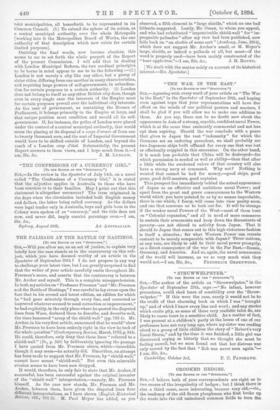THE PALISADE AT THE BATTLE OF HASTINGS. [To TEE EDITOR
OF THE " SPECTATOR."] SIR,—Will you allow me, as an act of justice, to explain very briefly how the case stands as to the controversy on this sub- ject, which you have deemed worthy of an article in the Spectator of September 29th P I do not propose in any way to challenge your latest view, but I am greatlysurprised to find that the writer of your article carefully omits throughout Mr. Freeman's name, and asserts that the controversy is between Mr. Archer and myself. This is a complete misapprehension. In both my articles on "Professor Freeman" and "Mr. Freeman and the Battle of Hastings," I was careful to lay stress upon the fact that in his second and latest edition, an edition for which he "had gone minutely through every line, and corrected or improved whatever seemed to need correction or improvement," he had explicitly, in the only place where he quoted the disputed lines from Wace, declared them to describe, and describe well, the time-honoured " array of the shield-wall" (pp. 763.4). Mr. Archer, in his very first article, announced that he would" show Mr. Freeman to have been entirely right in the view he took of the whole question" (Contemporary Review, March, 1893, p.344). He could, therefore, only deny that these lines " referred-to a shield-wall" p. 349) by deliberately ignoring the passage I have quoted from Mr. Freeman above, which—incredible though it may seem—he actually did, Since then, an attempt has been made to suggest that Mr. Freeman, by " shield-wall," cannot have meant "shield-wall." But even this miserable evasion seems to have been now dropped.
It would, therefore, be only fair to state that Mr. Archer, if successful, has been successful against the original inventor of the " shield-wall " interpretation,—namely, Mr. Freeman himself. As the ease now stands, Mr. Freeman and Mr. Archer, between them, have given the disputed lines four different interpretations, as I have shown (English Historical Review, viii., 231.2). M. Paul Meyer has added, as you observed, a fifth element in "large shields," which no one had hitherto suggested. Lastly, Mr. Oman, to whom you appeal, and who had substituted "impenetrable shield-wall" for " im- pregnable palisades " after my view had been published, now falls back on "an abattis of some sort" (Academy, June, 1894),, which does not suggest Mr. Archer's small, or M. Meyer's large, shields, or indeed a palisade at all, but must—if the word is properly used—have been mainly constructed of the "hoar apple-tree."—I am, Sir, &c., J. H. ROUND.
[Wo dealt with the matter solely on account of its hietorical, interest.—ED. Spectator.]






































 Previous page
Previous page